With a beautiful and stunning array of flowers, this plant is a sure delight! Here’re all the details on How to Grow Celosia and Its Care!
USDA Zones: 10-12, 2-9 (As an Annual)
Botanical Name: Celosia
Colors: Red, Pink, Purple, Yellow, Orange, Burgundy, White
Common Names: Woolflower, Silver Cockscomb, Quail Grass, Cockscomb
The genus Celosia belongs to the family of Amaranthaceae. It is native to the warm climate of Africa and Asia and appreciated for the showy inflorescences that are colorful and unusual like no other flower. So, if you are looking forward to growing one, here are all the details on How to Grow Celosia!
Popular Celosia Varieties
- Celosia argentea: It has dark green coarse leaves with apparent ribs. The flowers are bright and colorful and can last up to 6 weeks.
- Celosia cristata: Its flower head resembles the head of a rooster, which is why it’s also known as cockscomb. It comes in colors like carmine red, yellow, white.
- Celosia plumosa: The flowers of this species are often dried out and preserved for decoration, as they keep their color for a long time.
- Celosia caracas: It flowers from mid-summer to fall with a lovely pink and purple hue. If you live in a hot climate, it flowers from fall to spring.
Best Climate to Grow Celosia
Celosias are popularly grown as annuals around the world. In temperate climates (USDA Zones 2-9), they are planted in warm weather after winters. Whereas, in hot regions (USDA Zones 10-12), they’re short-lived perennials and can be grown year-round with some care provided from the sultry summer heat.
Propagating Celosia Plants
You can propagate wool flowers from cuttings and seeds. Start propagation from April in subtropics and slightly cooler climates. If you live in a cold place, wait till mid-may, seed sowing can be done till July and beyond if temperature requirements are satisfied. In a hot climate (USDA Zone 11-12), wait till the summer ends.
From Cuttings
- Take a 5-6 inches long cutting from a healthy plant with at least 2-3 leaf nodes.
- Strip all the bottom leaves with a few remaining on top.
- Dip it in a rooting hormone (optional step)
- Place the cutting in soil. Keep it where it can get bright, indirect daylight.
- Once it forms roots (2-4 weeks) and begins to grow, transplant the cuttings into the desired place.
From Seeds
- Get the seeds of your favorite variety from a garden center or online.
- Sow them 1/3 to 1/4 inch (0.6 to 1 cm) deep in a seed tray or pot that has a well-draining soilless mix.
- Keep the soil moist and place the pot in bright light.
- Ensure the soil temperature is above 64 F (18 C), but you can start them when the temperature is as low as 60 F (15 C).
Requirements for Growing Celosia
Location
Celosia loves the sun, and to ensure abundant flowers, it should be under the open sky with good air circulation. If growing indoors, it needs a sunny window. To grow celosia in a balcony, Southern or Western exposure is important, where it can receive at least 5-6 hours of direct sun.
Watering
Although the plant can tolerate short periods of drought, it grows much better when the soil remains slightly moist. While watering, remember not to overwater plants and wetting the leaves to avoid leaf spots, stem, and root rot, along with other fungal diseases.
Soil
Celosia plant thrives in most soil types, but it is better to use soil that is loamy, rich in organic matter, and drains well. The pH level of the soil required should be around 6 to 7.
Temperature
Even though it’s a plant of warm areas, celosia can grow in both subtropics and warm temperate zones. It grows best as a perennial in areas where annual daytime temperatures are within the range of 68-86 F (20-30 C).
The optimum seed germination temperature for growing celosia is around 64-86 F (18-30 C), ideally, around 77 F (25 C). The plant can tolerate a maximum of 104°F (40 C) and the lowest to 32 F (0 C) for a brief period without frost.
Caring For Celosia Plants
Fertilizer
Fertilize the plant using a liquid fertilizer with an NPK ratio of 15-30-15 or 10-10-10 once a month. When the plant starts to flower, increase the fertilization frequency to once every 2-4 weeks.
Mulching
Outdoor planted celosia will benefit a lot from a thick layer of organic mulch. It helps the plant to retain moisture for a longer time duration. Mulching also helps in preventing the growth of weeds.
Pests and Diseases
Common pests and diseases that infect celosia plants are aphids and spider mites. For diseases, check for leaf spot, stem, and root rot.
To avoid infection–keep your plant healthy, water within the limit, and ensure good drainage. Spray with organic pesticide and fungicide if necessary.
If your potted celosia plant begins to wilt and grows up with difficulty, it is a sign of excessive watering or fertilizing. Planting in well-draining soil or a soilless potting mix and fertilizing according to the instructions will fix these problems.
A Perfect Balcony Plant
All it needs is a bright, sunlit location and a little bit of space to showcase its brilliant display of colors. So, if you have a small balcony, this is a perfect flowering plant to keep the gardener alive in you!
Celosia Uses for Landscaping
You can use showy celosia flowers in your landscape in various ways: They are available in many warm colors like pink, red, yellow, orange, purple, and off-white and look good in flower beds, borders, rock gardens. You can also create dramatic flower combinations with them. And last but not least–they become excellent cut flowers!

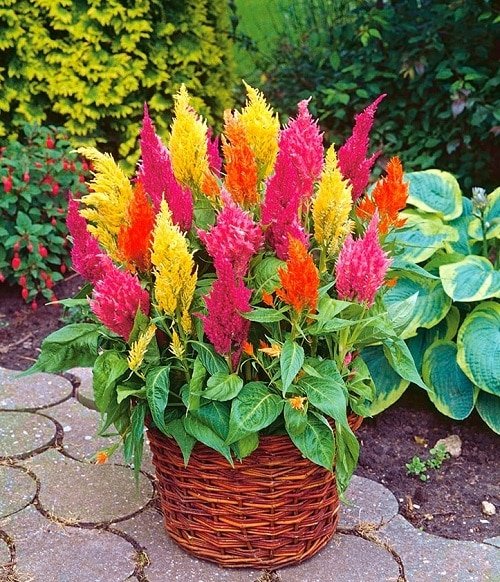
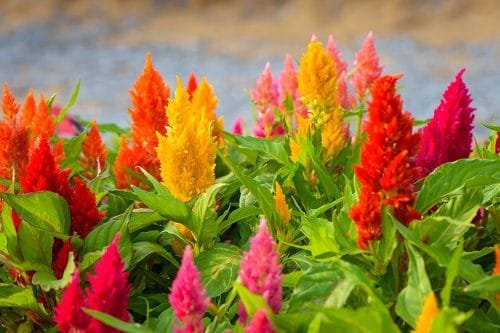
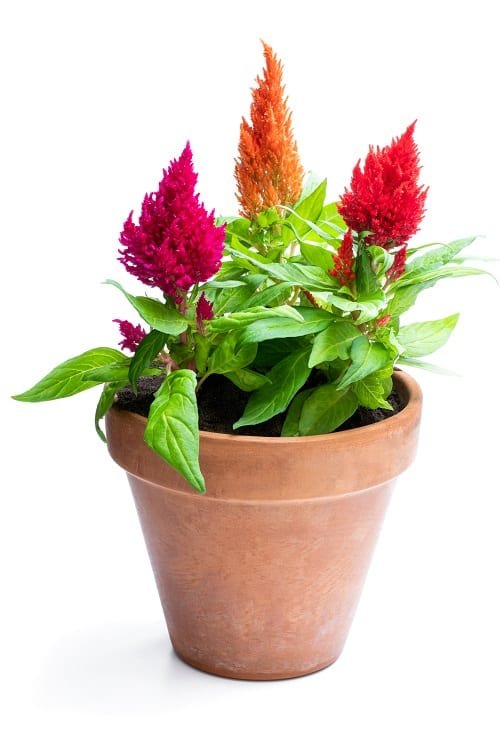
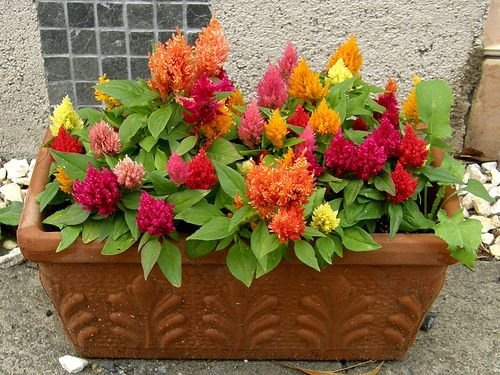
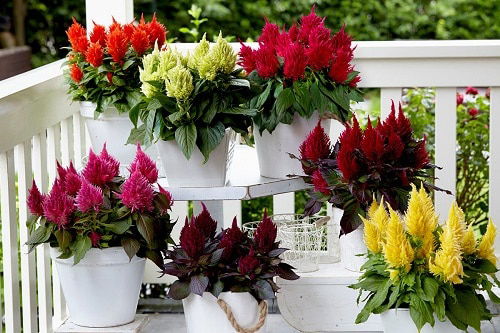


I want to know if you can grow Celosia Flamingo Feather Plants from cuttings. A nice piece broke off accidentally
from my young plant.
Thank You. Your Web Site is very nice.
I have rooted cuttings of plumed celosia with good success. I did 5 cuttings in water in a sun room and all rooted. They sent out a long, single root and then feeder roots came later. These cuttings rooted anywhere from 2 to 4 weeks. Three rooted in about 2 weeks and the last 2 took about 4 weeks. Stems were healthy throughout the rooting process.
I also tried 5 cuttings in sand. They also took about the same time to root but I had them outside where they got shade during the hottest part of the day. I kept the sand moist by setting the pot in a pie plate and put a milk jug over the top to hold humidity. On some days when there was intense heat, I watered the pot. I checked 2 of the cuttings today and they had roots and in more abundance than the cuttings in water. I will pot them up tomorrow.
From my experience, they are easy rooters and I did not use any rooting aid. I used side shoots from the ‘mother’ plant about 4 inches long. Pinched off any buds and took off the bottom leaves leaving only about 3 or 4. The cuttings with the 4 leaves seemed to have the better root system.
I am looking forward to growing this celosia in a pot this winter. It is very pretty. Should I pay attention to the size of the pot and the plant. are they easy to transplant?
I like celosia becoz i m floriculturist azalea camelia also my favourite
I have had 3 of them in my dart frog vivarium for the last year and a 1/2 in their still growing beautiful with the heat and humidity around 83 degrees
as it winter would it be best to get my plant in till the summer
I have found they thrive in larger, shallow round pots! Leave room for them to spread.